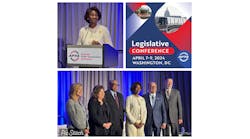One of the critical issues facing our – and many other – industries, is an employee shortage. Many of the Baby Boomers have already started retiring, and more will continue over the next decade. Also a focus of the industry has been attracting a diverse workforce.
We need to attract more women to work in transportation. We need to attract the millennials. We need to attract minorities. While I’m a fan of more diversity in the industry, those statements make me cringe. Doing a few strategic changes will lure them all in?
If we have more charging stations at conferences/meetings, millennials will flock to us. I really have heard that one.
There’s still a long way to go in the industry. I can’t count the number of times I’ve been asked if my son travels with me when I travel for work. Or that some think because I work from home, he’s there with me during the day.
Sitting around in insular groups discussing what changes should be made to attract others isn’t going to accomplish much. And as one of those groups being talked about, it’s insulting. It reminds me of Pope Francis telling people not to proselytize, but instead to inspire others. Don’t add some charging stations and continue the rest of it business as usual. Reach out and involve the people you say you want to attract more of. Inspire them to be involved.
The good news, there are so many seasoned professionals in the industry that do that. They not only welcome involvement, but they actively seek and encourage it. I have been fortunate enough to get that kind of help from many. They’re not focused on what they can do to get more recognition for what they’ve accomplished, they focus on what they can do to build others up, to build future leaders.
There was an infographic going around social media recently which brought all this to the forefront. The transportation industry survey included an infographic titled, “Women in Transportation Still Face Challenges.” Part of that included a series of women silhouettes — exaggerated, stylized silhouettes. They looked to be a cross between Barbie and some female superhero: coiffed hair, buxom, tiny waists, long legs and stiletto heels.
There was such a storm of a response from people about the graphic, the company took it down, apologized and reposted the information with different graphics.
While a marketing nightmare for them, it brought the discussion to the forefront. It’s important to foster an environment of inclusion so that when people are sitting around the table talking about how the industry can adapt with changing times, there truly is an interest in readjusting instead of being stuck in business as usual.


